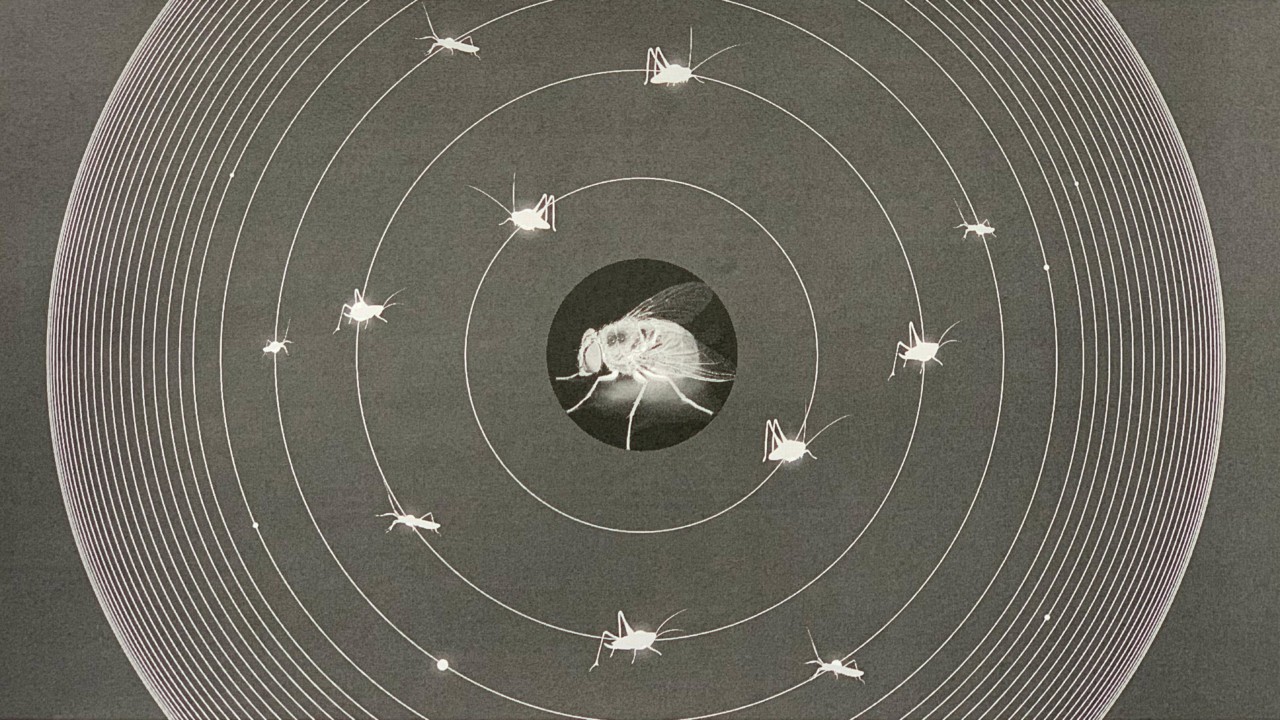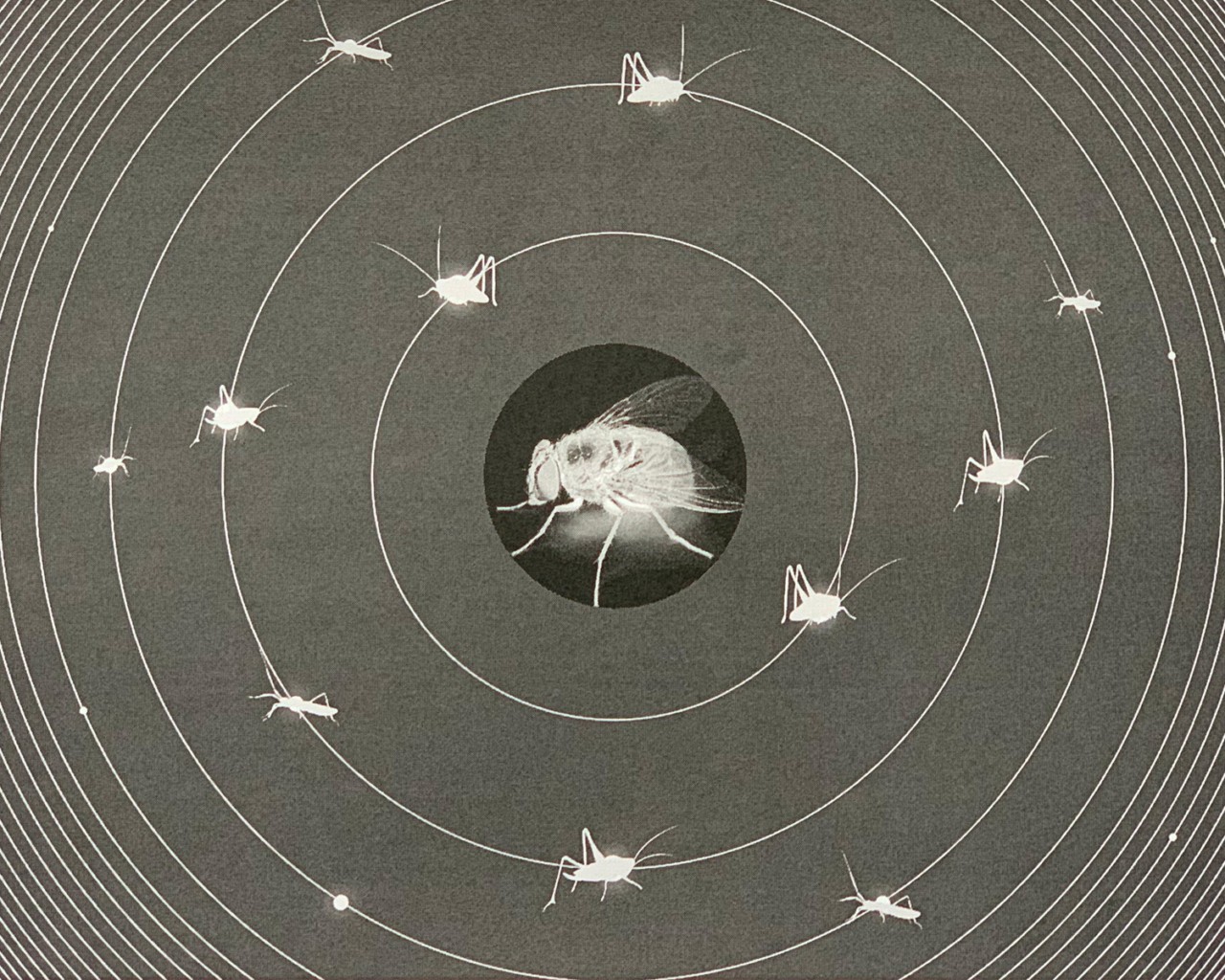

WORDS BY JASON P. DINH
artwork by yannick lowery
There’s a real-life version of A Quiet Place playing out in Hawaii—and a study published today shows that the deadly eavesdroppers are evolving as we speak.
Roughly three decades ago, a species of parasitoid fly descended on the archipelago from the United States mainland, and they’re bloodthirsty for their newfound hosts, Pacific field crickets. Armed with a keen sense of hearing, the flies, Ormia ochracea, intercept the piercing mating songs of male crickets to triangulate the crooning bachelors. Once the flies find their hosts, they deposit larvae on and around them. The grubs then burrow inside the crickets and, over the course of about a week, eat them from the inside out. It’s a gruesome way to go—and a demise the crickets are desperate to avoid.
Ormia flies present Hawaii’s field crickets with a catch-22: sing to attract a mate and court death, or go without and evade the lethal parasites. Five to 10 years ago, a solution evolved: Some crickets started singing quieter, less pure-tone songs. Colorfully named “purring” and “rattling”, these muted tunes still attract mates—albeit less effectively than a typical song—but they allow for safe, furtive courtship.
Now, however, researchers say the flies have also evolved. In a study published today in the journal Current Biology, scientists reported that Hawaiian Ormia flies have evolved more sensitive hearing which can detect purring and rattling songs. The new research shows that the crickets’ newly evolved calls are half-concealed but not invisible, pitting the insects in an evolutionary game of cat and mouse.
“It continues to build this system as a great example of evolution in action,” said Dr. Michael Reichert, a behavioral ecologist at Oklahoma State University who wasn’t involved with the study. “Now, it’s expanded to an example of coevolution in action, which I think is really exciting… To see this playing out in real time I think is very impactful. It’s going to be a classic.”
The new paper presents findings from an extensive series of lab and field experiments.
First, the researchers showed that Ormia ochracea from Hawaii have more sensitive hearing than individuals of the same species from Florida—where Ormia ochracea is native and novel purring and rattling cricket songs do not occur. They demonstrated this by playing a series of pure tones for the flies, measuring how loud the sounds needed to be to activate the flies’ neurons, which they monitored using a tiny electrode.
“It’s expanded to an example of coevolution in action, which I think is really exciting. It’s going to be a classic.”
The Hawaiian crickets’ neurons responded to much quieter sounds than Floridian ones, especially at the pitches that best characterized typical cricket songs and purring songs.
Dr. Robin Tinghitella, a study author and an evolutionary and behavioral ecologist at the University of Denver, was surprised at how neatly fly hearing differences aligned with cricket songs. “I was actually blown away,” she said.
The hearing differences weren’t small, either. Based on mathematical models that take into account the neural tests, Hawaiian flies should be able to detect singing crickets at much greater distances than their Floridian counterparts: 40 meters farther for typical songs, 3 meters farther for rattling songs, and a quarter of a meter farther for purring songs.
The researchers then showed that Hawaiian crickets behaviorally responded to quieter songs than Floridian ones. They synthesized cricket songs with varying pitch content and played them to the flies at different intensities. The flies were tethered to a table tennis ball, which—like a treadmill—spun when the fly walked. A sensor logged that rotation onto a computer. Consistent with the first experiment, Hawaiian Ormia ochracea walked toward quieter stimuli than Floridian ones.
“If you show a difference in the auditory brainstem response, that doesn’t always clearly transfer to a behavior,” said Reichert. “I think what’s nice is that they do actually connect that to the behavior.”
The team’s final experiment showed that Hawaiian flies, with their enhanced hearing, can detect purring and rattling songs in the wild. On a manicured lawn at Brigham Young University–Hawaii, they set up a circle of 13 fly traps crafted from two-liter soda bottles, each one spaced three meters away from the next. Each trap contained a speaker broadcasting either a cricket song or a control treatment: one ancestral song, five purring songs, five rattling songs, one white noise, and one silent speaker.
Although 81% of the flies they caught localized the speaker playing the ancestral song, 5% homed in on the purring songs and 14% on the rattling songs.
“It’s actually wild that any of them are going to any of these novel songs,” said Tinghitella, considering there was a typical, ancestral song playing at most about 12.5 meters away.
“This attack on federal funding means we can’t support the basic science that allows us to learn how the world around us works, but we also can’t support the diverse and wonderful people who make that work possible.”
The authors say this is the first known example of an eavesdropper rapidly evolving its sensory ability. However, they acknowledge that fly hearing may not have evolved in response to purring and rattling. It’s possible that hearing differences arose from random changes—a phenomenon called genetic drift. It’s also possible that the flies evolved enhanced hearing when they first invaded Hawaii but before purring and rattling arose. That would have helped the newcomers cast a wide net for a new host, Tinghitella said.
The authors are now testing whether Hawaiian crickets have evolved their hearing sensitivities, too, but they’re worried political attacks on science could threaten this work.
Tinghitella’s National Science Foundation grant that supported this project was flagged last week by Texas Sen. Ted Cruz as part of his “Woke DEI Grants at the NSF” database. As part of Tinghitella’s grant, her team supports LGBTQ+ scientists and mentors diverse undergraduate students in research. NSF froze funding last month as it screened grants for DEI-coded language.
“They’re sending a really clear and terrifying message that building community and mentorship structures for underrepresented students and faculty in order to make science a more welcoming space is not only not valued, it’s not allowed,” Tinghitella said. “This attack on federal funding means we can’t support the basic science that allows us to learn how the world around us works, but we also can’t support the diverse and wonderful people who make that work possible.”
Dr. Norman Lee, a co-author of the new paper and a neuroethologist at St. Olaf College, is stressed about the politicized state of science, too. Like Tinghitella, his grants include efforts to broaden participation in science. His eyes welled up as he thought about what a funding freeze would mean for his mentees. “I want to engage as many of my students in the research as possible,” he said. “Is that being seen as what they think is being woke?”
Although the news anguishes him, Lee finds solace in the crickets and the flies. Each has presented the other with unprecedented, existential challenges—but both have adapted and survived. This latest paper provides yet another example of that.
“There’s this level of resilience in the system… It’s hardy,” Lee said. “And I see a level of resilience that we will also ride through this current political climate.”
‘A Quiet Place’ Is the Lived Reality for These Hawaiian Insects